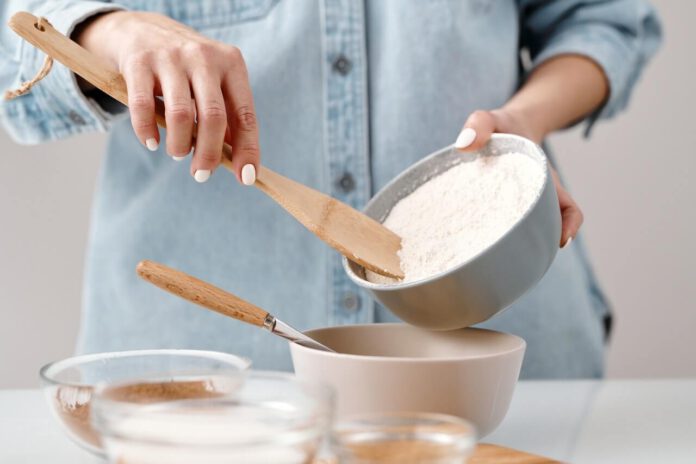Gluten-free flours: a Christmas guide for beginners
Contents:
- Potato flour (starch)
- Arrowroot root flour
- Flour from pulses
- rice flour
- Starch and corn flour
- Tapioca flour
- millet flour
- Oat flour
- Nut flour
The holidays are just around the corner and people who follow a gluten-free diet are faced with a dilemma: How best to prepare Christmas cookies since conventional flour is not an option?
Anyone asked about their Christmas associations will sooner or later mention food, and very often it's cake! Whether it's cheesecake with a shortcrust pastry base, poppy seed strudel, fruit cake, or gingerbread – baked goods are an inseparable part of the Christmas tradition. There's no reason why people who avoid gluten should miss out on this undeniable treat: There's a suitable gluten-free flour or gluten-free blend for every culinary need. To help you understand the impressive variety of alternatives to gluten-containing flour, we've compiled a brief description of the most popular gluten-free flours.
Potato flour ( starch ):
Everyone knows it and it's often used in cooking and baking. It's white and tasteless. It has excellent adhesive properties and also improves the structure of baked goods (which is why it's added to shortcrust pastry in traditional baking). It's therefore excellent in gluten-free mixes, but can't be used on its own.
Arrowroot flour:
Very similar to potato flour – they can be used interchangeably.
Pulse flour:
They are made from ground raw beans, peas, chickpeas, and other legumes. They are rich in protein and fiber, but have a distinctive flavor and often a distinctive color. They are especially popular in chocolate and spiced baked goods, as the strong aroma masks the bean flavor. This also includes flour made from peanuts, which are a type of bean and not "true" nuts.
Rice flour:
When made from brown rice, it's relatively high in protein and fiber, making it a good base for mixes. It's one of the most popular gluten-free flours, often added to mixes and sometimes even used on its own, especially in lighter baked goods.
Corn starch and flour:
Corn flour has a distinct corn flavor and a yellow color, as well as a rather coarse texture, while starch is white, very fine, and similar to potato flour. Corn starch is ideal for adding a nice crispness to baked goods, and the flour can be used in most baked goods, often on its own.
Tapioca flour:
A neutral-tasting white flour made from cassava, a plant native to South America. It adds a lighter texture to baked goods, yet adds a bit of crispiness and substance, which positively impacts the eating experience. It's often used as an ingredient in gluten-free flour blends, but it's not often used on its own. It works very well in cookies!
Millet flour:
Light yellow flour produced by grinding millet and therefore naturally similar in flavor to millet. It's high in protein and fiber. Perfect for baking cakes and cookies, and often even bread.
Oat flour:
It may have an unsightly, typical "oatmeal" color, but it's a great base for soft baked goods. It works less well when a brittle, harder texture is needed. Keep in mind that not all oat flour is gluten-free—check the packaging for information!
Nut flours:
Almond and coconut flour are the most popular. The sweet, distinctly nutty flavor of this flour is perfect for making Christmas cookies. It's ideal for making cookies and shortcrust pastries, but usually requires mixing with flours with a lighter texture.
THE PUBLISHER'S CHOICE
Almonds 1 kg BIOGO
- €11,69
€13,75- €11,69
- Unit price
- / per
Walnuts 800 g BIOGO
- €8,65
€10,18- €8,65
- Unit price
- / per
Dried organic mango 400 g BIOGO
- €10,99
- €10,99
- Unit price
- / per
Dried White Mulberries 500 g ORGANIC
- €5,84
€6,87- €5,84
- Unit price
- / per
Dried organic figs 800 g BIOGO
- €30,12
- €30,12
- Unit price
- / per
Unpeeled buckwheat groats 1 kg BIOGO
- €2,81
€3,31- €2,81
- Unit price
- / per
Organic coconut flakes 500 g BIOGO
- €10,07
- €10,07
- Unit price
- / per
Organic oat flakes 600 g BIOGO
- €3,77
- €3,77
- Unit price
- / per
Organic cashew nuts 1 kg BIOGO
- €19,99
- €19,99
- Unit price
- / per
Milk thistle seeds 1 kg BIOGO
- €3,99
- €3,99
- Unit price
- / per









































































































































